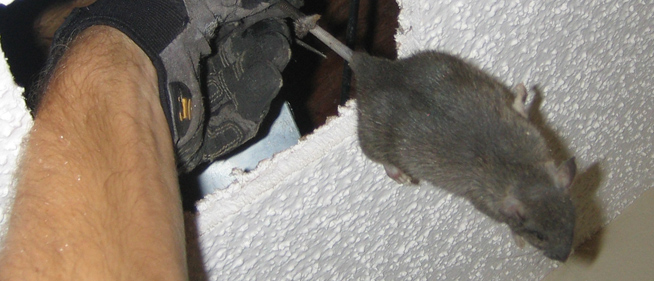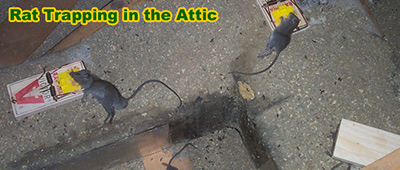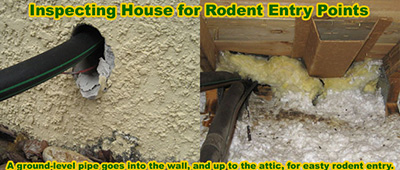Rats will live in any part of the architecture, from the basement up to the attic, and of course, in between, the walls. Sometimes they
live and rat nest in the walls, and sometimes they just run up and down the walls, via wires and pipes, as they travel through the house,
perhaps from ground-level entry points up to the attic.

In the photo above, we see a pest control operator about to set a trap for a mouse in a wall. Rats and mice rarely carve out such nice holes to live in, and so it's not so obvious. But what is obvious, in the second photo, is the stench of a dead rat rotting in the walls. It's actually very hard to pinpoint the exact source of the odor - it could be in the ceiling, under the house, etc. But a good pro will be able to sniff out the spot and find it. Oftentimes, rats fall down the wall, and can't get out, and then die. As you can see in the photo on the right, there's really nothing to climb out here, so the rat is stuck at the bottom of the wall.
IF A RAT IS STUCK IN A WALL
If it's stuck, then you either have to get it out from above, in the the attic, or cut a hole in the wall. It's rare to actually have good attic access with a clear path down a wall. It's just not common
in many architectures, or the wall is at the edge of the house, or in a place with no good attic access. But if you do have access, you can get the rat at the bottom with a snare pole, or lower a rope so
that it can climb out. The other option is to cut a hole in the drywall. If the rat is alive, you can grab it with a thick set of gloves (yes, they can bite), but they're super fast and agile, so you can't
let it escape and get out. You can also use a towel, or set a trap right at the hole you cut out. If it's dead, of course you just have to remove it.
IF RATS ARE RUNNING UP AND DOWN THE WALLS
In this case, if they can get out, and are just running along wires or pipes, then it's basically the same principle as rats in the attic. To solve the problem, you must seal the entry holes into the house.
It's not feasible to set rat traps inside walls, so the actual trapping must be done in other areas, such as in the attic.
WALL SCRATCHING NOISES
Wall scratching is always a cause for alarm. Not only do you need to determine what kind of animal is making the noise, you need to figure out how to remove that animal before significant damage
occurs within your home. Most scratching in the wall is from rats mice. Other common offenders are raccoons and squirrels. If you were born under an unlucky star, you might have an opossum.
Getting rid of the scratching in your wall should be a priority, but regardless of the animal responsible, you have another problem to address first: there is a hole in your house. Mice and other
rodents aren't built into a home's structure. These animals find their way in through holes in the home's exterior. Before you can eliminate the pest you have to eliminate the entry hole. Once the
opening has been sealed, nuisance animal control can begin. Determining what animal is causing the scratching will be your next step. Mice and rats can be trapped with lethal, snap traps. Squirrels
need to be captured in repeater traps or excluded from the house using a one-way door. Once the animal has been identified and removed, cleaning up the area is important to prevent alluring odors
from drawing more wild animals to the house.
THE SAME APPLIES TO MICE
Although I wrote this site with rats in mind, such as the Roof Rat and Norway Rat, the same principles apply to other rodents, such as the house mouse. Mice
behave very similarly to rats, they're just smaller. Email me if you have any questions about how to remove a mouse in the wall, mice in the walls, get rid of rodents
in the walls, or how to get rats out of walls. You may hear rat scratching sounds in the walls, or running noises in the walls at night.

How to get rats out of a wall
There are a few steps you will need to take to get rats out of a wall, and for the most part, the majority of that work will be spent inspecting, and then repairing. This is to ensure that once you get those rats out, they don't ever gain access to your home again. That's the aim of the game - to get these animals out and to keep them out. You might trap a few with rat traps, but you won't solve the problem. They will just keep coming back, thick and fast. A female rat can have litters up to five times per year in the right conditions, and that means one hell of a rat problem for you and your home or commercial property.
The aim of the game here is to find any holes that the rat could be using to gain access to your property. You will need to find the main areas that the rat or rats frequent, and that's where you would use your exclusion devices. These most-used holes are going to be your best bet to get rid of the entire party of rats, and the smaller, lesser-used holes are going to be sealed up. They'll be forced to use the main holes, where your exclusion device is situated, and once they've left, they are unable to come back in again.
In order to find the most-used areas of your home by these rats, you could use something like flour - a white powder. Sprinkle the powder down in the areas which you believe the rat is running around, and when you come back after a few hours or days, you will see dainty little footprints if you're right. If the flour hasn't been touched, however, you are barking up the wrong tree. Either hat or you need to wait a little longer.
The thing you need to remember when sealing or repairing your home is that rats will chew and gnaw through any material that you put in front of it. Wood provides no barrier, and plastic can be added to the same useless category. If you put these materials down iny our repairs, the rats will chew straight through them, and if they don't, another animal will. You should be looking at using mesh / steel wiring and screens to keep the critters out. They can't chew through that.
If you do not do all of these things, you won't ever get rid of your rat problem. They will keep coming, and that's even more so the case if you don't do a proper clean up job after they've gone too. Their urine leaves behind pheromones, and those are designed to attract other rats. It won't be long before you've got another very big problem on your hands, and all of your hard work will have been a total waste of time.
Go back to the Rats in the Attic home page.
A common route for rats and mice to get into your house is through your eves. Rats are great climbers, and there are often numerous openings in the roof that allow them entry. From the eves, they can easily enter the wall cavities. From there they can either make a cozy home from which to come and go or worse, they can get themselves stuck. This can be problematic for a number of reasons. Scurrying sounds, damage to structural materials, droppings, and eventually if you don't take care of the problem quickly, a very unpleasant corpse to get rid of. It's within your best interest to address the issue as soon as possible. Here are a few options depending on your situation:
If the Rat Can Move Freely
Most of the time, it will be obvious which wall the rat has chosen for its home. The first thing you need to do is find the entry point. This will be a well-traveled thoroughfare, especially for rats, who go out to forage during the day and return at night. This could be the opening to the wall from the eves, a gap in the skirting boards, or even a small hole made for a pipe that the rat has gnawed bigger.
Once you have located the entrance hole, use a trap of your choosing to bait the rat out of your wall. There may be more than one entrance, so be vigilant when inspecting your home. Bear in mind in this scenario, it's very likely for there to be a nest inside the wall if the rat is regularly returning to the same place. If this is the case, you will be able to trap the adult, but the babies won't be able to climb. They will have to be manually removed.
If the Rat Is Trapped, or Dead
If you have tried luring the animal out through the entrance, or if you hear constant scratching from one particular place, the animal is likely trapped. At this point, you will have no choice but to physically remove it. It may be that you can see down into your wall and grab it with a long pole or snare, but if the line of sight is broken it will need to be cut out of the wall.
While it's possible to do this yourself, in order to minimize damage to your home and to make it as painless as possible, it's a better idea to call a licensed professional.
If the scratching stops one day, don't automatically assume that the rat has gone. If it gets stuck for a decent amount of time, it won't be getting out without your help. In all likelihood, you now have a corpse on your hands.
A decomposing rat is potentially even worse for the home than a live one. The corpse can attract fleas, and if it's near any vents or air ducts then it can fill the whole house with the smell of dead rat. You can either cut into the wall that's emitting the smell or call a professional to do it for you. Dealing with cadavers is not to be taken lightly, and if you do take the DIY approach, make sure to wear protective clothing and sanitize the area well afterward.








